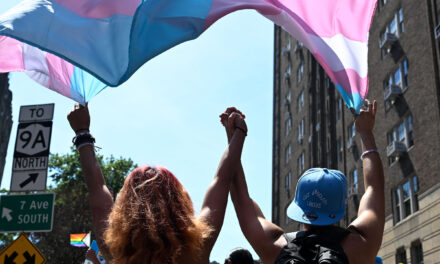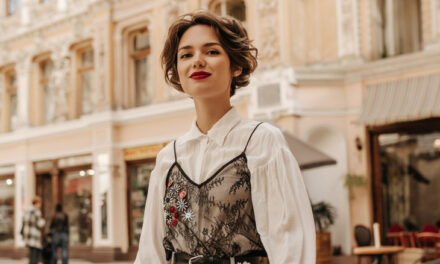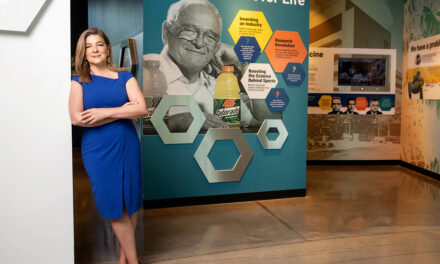
One day, about two years ago, I looked in the mirror and was shocked to discover that my once-fabulous tits had transmogrified into a bosom. Whereas breasts—those sexy appendages that had gotten me past velvet ropes and bar tabs aplenty in my 20s and 30s—might be sexy and evocative, the bosom, despite its large size, is solely utilitarian, meant for comforting crying children against or storing Kleenex at weddings and funerals.
As she aged, Nora Ephron felt bad about her neck; I could no longer see my neck. Sometime in my 40s, everything above my hips had, you see, been incorporated into the bosom’s new terrain. My head sort of just perched atop my bosom, which sat atop my waist and my still-skinny legs.
I had seen this body before: on my mother, my grandmother, my great-grandmother, and an assortment of aunts and great-aunts. It was a physique typically packaged, in my family at least, with short haircuts, a purse full of peppermint candies, and blousy, beaded tops for “dress occasions.” It was what I’d always considered “Doña Body” and is well documented in generations of family photos of “mature” women seated together, smiling, their ample bosoms lined up in a row. And suddenly, there that body was, in my own mirror.
How could this be? I wondered. I am 46; I am not a doña—certainly not yet. I am not married; I have no children. All of my nieces and nephews are common-law.
Chronologically speaking, of course, the timing for my metamorphosis was about right. My grandmother married at 17, was a mother at 18, and was a grandmother of two by the time she was my age. The story was the same for most of the women in my family—matriarchs of multiple generations all before 50. I had thought that the Doña Body was about a lifestyle. It was hard for me to accept that it was simply a product of the passage of time.
It was so hard to accept, in fact, that I decided to do something about it. Something drastic.
I had never considered getting Botox or fillers. I used anti-aging creams and night masks only haphazardly. And I have a general aversion to doctors and blood and stitches. But the Doña Body was a bridge too far on the aging journey—one that I was not yet willing to cross.
I decided to have a breast reduction.
The chiropractor I was seeing every other week for the back pain that my boobs caused me agreed. A consultation with a plastic surgeon left me even more certain. This was about more than just not looking like a tía. I would get back to running! I could do yoga without smothering myself! I could wear normal bras! I would have a torso again! I signed up on the spot.
I don’t know that the older women in my family were less shocked by the ravages of time than I was. They were simply more accepting that once “the change” began—one of the many euphemisms for menopause that proliferated at the time—their role in society also changed.
I have a distinct memory of my grandmother staring in the mirror, holding the wedding dress she could hardly believe she’d once fit into. For years, my favorite aunt talked about trying to “get her shape back.” All of my aunts taught me early on how to wash my face to avoid wrinkles for as long as I could (hot water, then cold water, no soap) and how to apply face cream (upward motions, always, and don’t forget your neck). But beyond that and a box of Clairol hair color, what else was there really for them to do? These were working-class women in the ’70s and ’80s. Anti-aging technologies were limited by their time and also their class.
Mérida Rúa, an ethnographer at Northwestern University, studies aging among Puerto Ricans in Chicago, some of whom live in state-subsidized senior housing. Across classes, “the women that I interview take such pride in how they look,” she told me. But the working-class women “have to accept aging and the way that they age, because they don’t have the disposable income to do the other things.”
There are, suddenly, so many other things that they could do! Hormone-replacement therapy. Hair-thickening pills. Botox. Juvéderm. Microneedling or laser therapy for facial wrinkles, and something new called Morpheus8 that somehow combines microneedling and laser therapy. You can eliminate your midlife gut with a procedure called Sono Bello; you can get rid of late-life chin wattles with laser Kybella; you can even “rejuvenate” your vagina. Then, of course, there are the far-less-invasive “maintenance” procedures: the creams and the masks and the evolving world of high-tech facials.
I was raised with that very blue-collar outlook—color your grays and accept your fate—but socialized in quite another. I went to college, then into a career planning luxury events for women who could afford to look 10 if not 20 years younger than they were. I became a writer, which means I get invited to readings and book events and a surprising number of parties. I don’t want to look like one of those shiny-faced grandmas trying to be immune to time, but I still live in a world where J.Lo exists. So, long before the breast reduction, I’d been asking myself: What is the right way to age?
Joanna Vargas is an aesthetician and the owner of an eponymous line of skin-care products and spas. Once a month or so, I visit her Fifth Avenue spa, where a soothing and hilarious woman named Kiara goes over my face with a microcurrent wand for 60 minutes.
Vargas says that women tell her all the time, “‘You know, one day I was walking down the street, and out of the corner of my eye, I saw the reflection of an old lady in the window. And then I looked, and I realized that was me.’ And that’s what motivated them to come in.”
But what exactly is it about the old lady that we’re so afraid of?
The women Rúa interviews all say that “as they got older, they became invisible.” They don’t necessarily want to look younger, only to feel that “I have value, I have relevance … You know, you need to look a certain way for people to actually want to pay attention to you.”
Despite the gerontocracy in our government, everyone knows that our culture puts a premium on youth, especially for women. Old people have become more and more isolated as young people move to urban centers to work. Gentrification has transformed once-multigenerational communities into monoliths of young professionals and families. “People just stopped seeing old people around,” Rúa explained to me.
That mindset reached a sort of nadir during the coronavirus pandemic, the photographer Ari Seth Cohen told me: “People just were like, Okay, well, older people are going to die.”
For 15 years, Cohen has been celebrating fabulous older women through his books, documentary films, and social-media account @advancedstyle. Cohen views his project as a political one, designed to combat the invisibility that Rúa spoke about.
Young people seem to fear growing old more than they fear any of the horror-movie bogeymen Hollywood conjures up. What, other than fear, can explain why Gen Z—people ages 13 to 27—spend more on anti-aging skin-care products than any other generation? It is part of a movement called “prejuvenation” that’s sending 20-somethings to their dermatologists seeking “preventative Botox” injections. The message that we are internalizing at a younger and younger age is that aging itself is bad. Allowing yourself to seem to age? Unacceptable.
This attitude seems no less self-punishing than the diet culture of the ’90s, which, I can attest, was very hard to shake. The difference, of course, is that—through restraint and work and even self-harm—one can remain thin. But age eventually catches up with all of us.
The night before my surgery, feeling perhaps a bit of sadness at losing my identity as a “large-breasted woman,” I took a last look at my breasts in the mirror and—on the advice of a friend—Marie Kondo’ed them. I thanked them for their (purely cosmetic) service, and bid them, in their current iteration, farewell. At the hospital, the surgeon twisted each of my breasts up as if he was about to cut bangs and marked them with a Magic Marker. This was, he explained, a French technique. The anesthesiologist chatted with me about Kim Kardashian on American Horror Story. And then I went under.
The morning after, stuffed though I was with gauze and pads, I felt lighter. My best friend took a picture and sent it to our group chat. “You look 25 years old,” another friend wrote back. I did look younger (though 25 was probably an exaggeration), but as I healed, I realized that I didn’t feel younger. What I really felt was restored—like a classic car that runs well again. My gait has changed; my sense of energy and purpose in my movement has changed—no longer is every sudden movement a back injury waiting to happen. I feel rejuvenated.
To feel younger would be to have this same body and not think it was enough. To feel younger would be to have this same body and compare it, incessantly, with the bodies of others: women I know, models and actresses I don’t. To feel younger would be to have this beautiful, fit body and squander it by living in an endless loop of insecurity and envy and doubt. So losing the bosom might have made me look younger, but I feel—thankfully—a solidly healthy 46. I’ve probably lost 10 pounds of breast weight, but I still carry on my chest all of the experience and losses and victories that add up to what I hope is some measure of wisdom.
Suddenly, I have a second chance at life with a body I didn’t fully appreciate the first time around. What will I do with my second chance?
Perhaps the greatest irony of the prejuvenation movement is that whereas younger women are more frightened of appearing older, many women in middle age and beyond seem to be finding a new level of comfort with aging. They are helped in no small part by the beauty and staying power of superstars such as Viola Davis, Sandra Bullock, and Gwyneth Paltrow, who talk openly about their age, and by projects like Ari Seth Cohen’s.
The women Cohen highlights tend to be sartorially flashy and unapologetic about their age. “One of the women who’s in my documentaries is in her 90s,” he told me, “and she always just said, ‘I don’t want to look younger. I just want to look the best I can at any age.’” He hates the term anti-aging, which he finds dangerous: “Anti-aging really just means death, when you think about it.”
“As you get older, I think what we’re chasing is more of a feeling,” Joanna Vargas, the aesthetician, said. Women tell her, “I want to feel like I’m happy in this body. In this skin.”
Nina Lorez Collins, the author of the book What Would Virginia Woolf Do?, describes herself as “a little bit of a pioneer in talking about menopause.” She feels that menopause was the great divide in her aging journey. Before that—when she was my age, in fact—the entire aging thing seemed infinitely scary: “Once you’re in menopause, it really does start to get better for, I think, pretty much everyone. Once you figure out how to manage the symptoms and you kind of reckon with the way your looks are changing, I think most people come to a place of acceptance.” You start to realize “how much wiser and calmer you are,” she told me.
Wiser and calmer is the best way I can describe Katie Lee Biegel, a co-host of the cooking show The Kitchen. I’ve known Lee Biegel for a long time, and I asked her what it feels like to age in front of a television camera. Paradoxically, she told me, the older she gets, the less preoccupied she is with the anxieties of appearance. Although she, too, has feared looking “matronly,” she refuses to chase perfection. “I don’t want to work out for an hour and a half a day,” she said. “I just don’t have time for that.”
Both Collins and Lee Biegel—like a lot of women I spoke with on and off the record for this essay—were very open about their past Botox use. “I started getting Botox when I was 35,” Collins told me. “What the fuck was I thinking?” Lee Biegel had gotten Botox fairly regularly pre-pandemic, but when she went back more recently to try a new filler, she walked out with a black eye that lasted for six weeks. Both women, for now, have decided to moisturize and make the best of things.
“Why do we torture ourselves?” Lee Biegel asked me toward the end of our conversation. She said that sometimes she’ll look back at a photo of herself from six months or a year ago and think, “I looked great, but meanwhile, when I took this picture, I was like, That’s disgusting; I look terrible.” We all do it, she said: “Why?”
After about 10 days on the mend, I was cleared to go back to work. It occurred to me, as I was getting dressed for a fundraising benefit for a board I’m on, that this was probably not what the doctor had in mind. I shoved my rejuvenated boobs and my medical-issue compression bra into a dress before making my way to the Brooklyn Public Library, where I immediately found myself being photographed for a media outlet covering the event.
This, if I’m honest, was another reason I’d had the surgery. Yes, my shoulders hurt, but I was also so tired of fretting about my breasts under the gaze of the public eye. Whether this top or that outfit made me look too sexy or too matronly was simply too distracting.
When I left the house that day, I thought I looked great. But when I saw the photo two days later, I found myself, just as Lee Biegel had talked about, picking it apart. Now that my breasts were smaller, my eyes zeroed in on my newly revealed stomach. I wondered why I hadn’t made time to watch a TikTok on how to find “my angles.”
Perhaps this might have been my moment, the beginning of my slippery slope, and no amount of change or modification or injection would ever have been enough to capture the feeling of me “at my best.” But then I got a text from a relative. My favorite aunt—one of the women immortalized in the family photos—had been struggling with cancer and had been moved into hospice care. I was warned that I should get there as soon as possible, and I didn’t give the photo another thought until now.
It was hard to believe, when I saw my aunt lying in bed, as thin as she was, that there had ever been a time when she’d been concerned about her weight. Seeing her bundled under blankets and in her cap, it was hard to believe that she’d ever complained to me about thinning hair or hot flashes. When I kissed her goodbye, I couldn’t help but notice how smooth and soft her face was. Despite the cancer eating at her, in these last moments of her life, she was still so beautiful.
I started out wanting to write an essay about how, with this bevy of choices in front of me, I should age. The answer, I realized, is gratefully.




